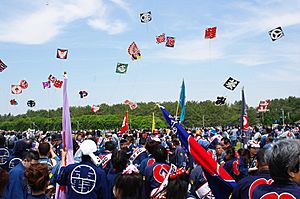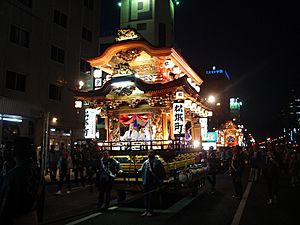Hamamatsu festival facts for kids
The Hamamatsu Festival (浜松まつり) is a super fun city festival held every year in Hamamatsu, Shizuoka Prefecture, Japan. It takes place from May 3 to May 5. These dates are part of Japan's longest national holiday, called Golden Week. May 3 is Constitution Memorial Day, May 4 is Greenery Day, and May 5 is Children's Day. During the festival, people celebrate children, especially baby boys. Local businesses also wish for good luck and success.
A Look Back: Festival History
The very first Hamamatsu Festival happened way back in 1558. It was a special celebration for the birth of the son of the Hamamatsu castle lord. The lord and his helpers flew a kite with the baby's name on it.
During the middle of the Edo era (1603-1868), flying kites on Children's Day (May 5) became popular all over Japan. On this day, Japanese people usually celebrate boys. They pray for their growth, good health, and bright futures.
The Exciting Kite Festival
The Hamamatsu Festival is super famous for its huge kites! At 11 AM on May 3, more than 100 giant kites fill the sky. People holding the kites stand at the Nakataima Sand Dunes. They release all the kites at the same time when a trumpet sounds.
The Nakatajima Sand Dunes are one of Japan's three largest sand dune areas. This spot is perfect for flying kites because it overlooks the Enshu-nada sea. This means it has strong winds. The kites are decorated with baby boys' names. They also show special marks or designs for each town (chō). People believe that the higher the kites fly, the healthier the baby boys will grow.
Participants from each town also have kite battles! They intertwine their thick kite strings, which are about 5 mm (0.2 inches) thick. Then, they use friction to cut their opponents' kite strings. This exciting kite festival happens for three days during the daytime.
The Nighttime Parade
At night, the festival continues with a big parade! This parade features 83 palace-like floats in the center of Hamamatsu. These floats are large, movable carts decorated with beautiful scenery or sculptures. Each small town has its own float.
Girls ride on the floats and play traditional Japanese music. They use instruments like taiko drums, shinobue flutes, and bells. Other children, their families, and people from the town also help carry the floats around the area. The audience watches the colorful parade from the side of the road.



